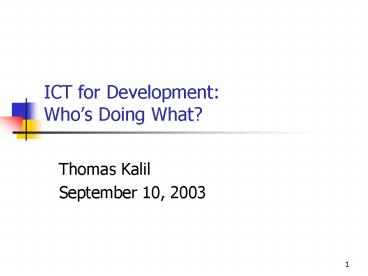ICT for Development: Who - PowerPoint PPT Presentation
1 / 24
Title:
ICT for Development: Who
Description:
Multinationals and local (developing country) firms. Foundations, non-governmental organizations, ... Agribusiness selling soybeans, coffee, shrimp, wheat ... – PowerPoint PPT presentation
Number of Views:43
Avg rating:3.0/5.0
Title: ICT for Development: Who
1
ICT for DevelopmentWhos Doing What?
- Thomas Kalil
- September 10, 2003
2
Who is doing what on ICT4D? (1)
- Huge variety of actors
- International organizations
- Developed and developing country governments
- Multinationals and local (developing country)
firms - Foundations, non-governmental organizations,
social enterprises - Research community, higher education
3
Who is doing what on ICT4D? (2)
- What are the capabilities, agendas, and
limitations of these different organizations? - What is their level and duration of commitment to
ICT4D - What is the right division of labor?
- Possible partnerships between different actors
4
UN ICT Task Force (1)
- Developing country participation in setting ICT
policy - Shortage of experts
- Low-cost connectivity
- Free or reduced cost access from satellites and
intl cables - National and regional Internet exchange points
5
UN ICT Task Force (2)
- Support for developing country entrepreneurship
- Human resource development
- National and regional e-strategies
6
World Bank (1)
- U.N. specialized agency
- Mission is to reduce global poverty
- In 2002 provided 19.5 billion, mostly in loans
- 1,800 projects in more than 100 countries
- 10,000 staff
7
World Bank as knowledge bank (2)
- Vision
- Capture and organize knowledge and experience
from staff, clients, partners - Share that information as widely as possible
- Put knowledge on par with money
- Become the first resource anyone would contact
for information on development
8
World Bank (3)
- 100 thematic communities of practice to
increase knowledge sharing - Advisory services
- Support for external initiatives such as Latin
American Urban Network - Development Gateway
- Capturing and sharing indigenous knowledge
9
World Bank (4)
- Critique of Development Gateway
- May undermine other efforts with richer and more
diverse content - Overly ambitious
- Reflects biases of the Bank and its shareholders
- Bank not serious about consultation with NGOs
10
World Health Organization
- Health InterNetwork Access to Research Initiative
- 28 publishers, over 2,000 journals
- Free access to public institutions in countries
w. under 1,000 GNP/capita - Reduced price for 1,000 - 3,000 GNP/capita
11
National e-strategies (1)
- Telecom and IT infrastructure
- Human capacity
- IT workforce
- Local entrepreneurs
- Users
- Public policy
- Competition in telecom Internet services
12
National e-strategies (2)
- Environment for private sector
- Access to credit and finance
- Property rights, commercial law
- Access to local and global markets
- Content and applications
- Local language content
13
Mozambique (1)
- Profile
- 2X size of California with 17.5 million people
- Life expectancy at birth of 31.3 years
- Civil war from 1977-92
- GDP/capita of 1,000
- 81 percent of labor force in agriculture
- Govt budget of 1 billion foreign aid of 632
million
14
Mozambique (2)
- Telecom/Internet
- 0.44 fixed line penetration
- 0.84 percent mobile penetration
- 60,000 Internet users 80 percent of which are
in Maputo (capital city) - Higher education produces 30-40 graduates with IT
skills
15
Mozambique (3)
- Elements of ICT strategy examples
- National Transmission Network
- VSAT stations
- Information systems for HIV/AIDS
- ICT for fighting illiteracy
- Youth Program for Content Development
- Telecom policy reform
16
Chile universal access (1)
- Reverse auction to provide rural access for
minimum subsidy - Multiple geographic licenses
- One stop process
- Licenses for rural areas combined with other
attractive opportunities - Good market research and demand analysis
17
Chile universal access (2)
- Supported payphone service to 6,000 villages with
2.2 million people (1995 2000) - Reduced population without any access to basic
voice from 15 to 1 - Over 61 leverage
- Subsidy only 0.3 of telecom revenue
18
HP e-inclusion efforts (1)
- E-inclusion allow everyone to access the
opportunities of the digital age - Motivation
- New markets, revenue, profit growth
- Establish HP as a leader in an area that also
demonstrates HPs character - Global showcase for HPs capabilities in devices,
infrastructure, and services
19
HP Labs India (2)
- Research thrusts
- Novel solutions for networking, esp. rural
- Affordable access devices
- Language technologies and simpler interfaces
- Sustainable business ecologies
- Contextual design
20
HP i-community in Kuppam, India (3)
- Access to technology for literacy, income
generation, expanded access to govt services,
education, health care - Kuppam as living lab for unearthing customer
needs - Ecosystem of partners (e.g. womens organization
for digital photography) - 3-year project to create bias for action
21
ITC Ltd. e-Choupal (1)
- Agribusiness selling soybeans, coffee, shrimp,
wheat - Has network of Internet kiosks (e-Choupals) in
rural India that reach 12,000 villages - Operated by literate farmer elected locally
- Supply chain more efficient results in
quality and cost savings shared with farmer
22
E-Choupal (2)
- Services
- Price information
- Risk management tools
- Weather information
- Best practices on farming, aquaculture
- Soil testing services
- Long-term goal is to reach 10 million farmers in
100,000 villages
23
Infocentros El Salvador (1)
- Current access in El Salvador
- Fewer than 2 PCs for 100 inhabitants
- Less than 1 of the population uses the Internet
- Goal of Infocentros
- Build, operate, franchise 100 telecenters
- Provide access for 1/3 of population
- Make centers profitable in 2yrs
24
Infocentros (2)
- Services
- Able to negotiate volume discounts on hardware,
software, connectivity - Web hosting, financing, accounting, billing for
small and medium-sized business - 8 hrs of computer/Internet training for students
(Ministry of Education) - Generation of local content































